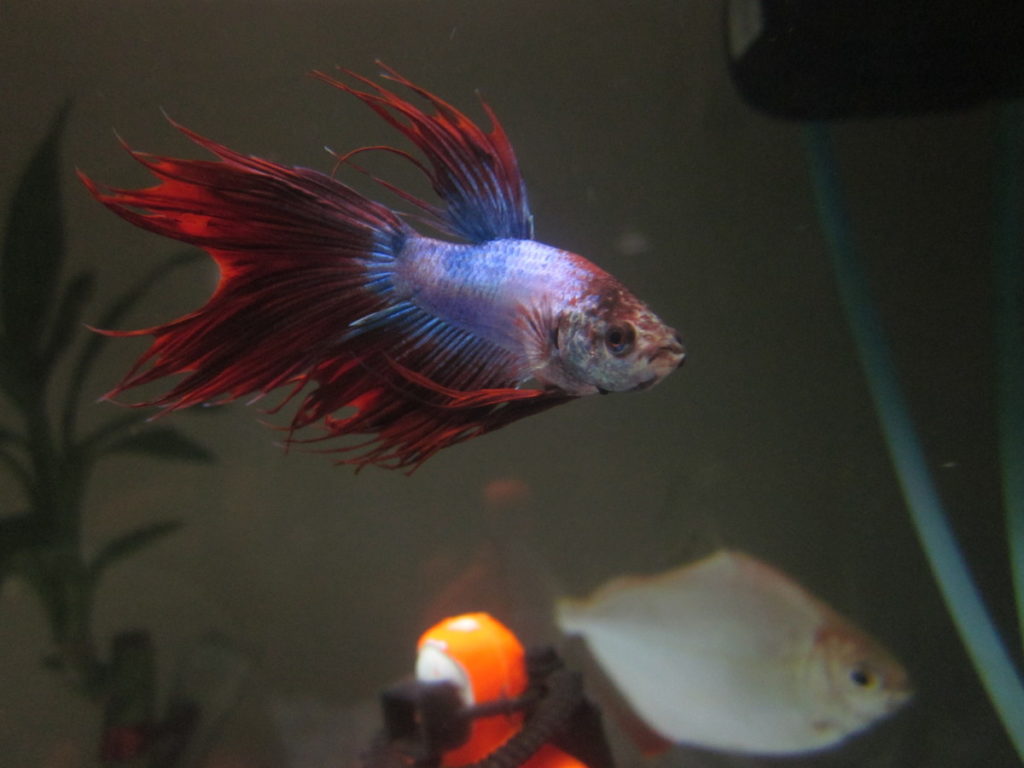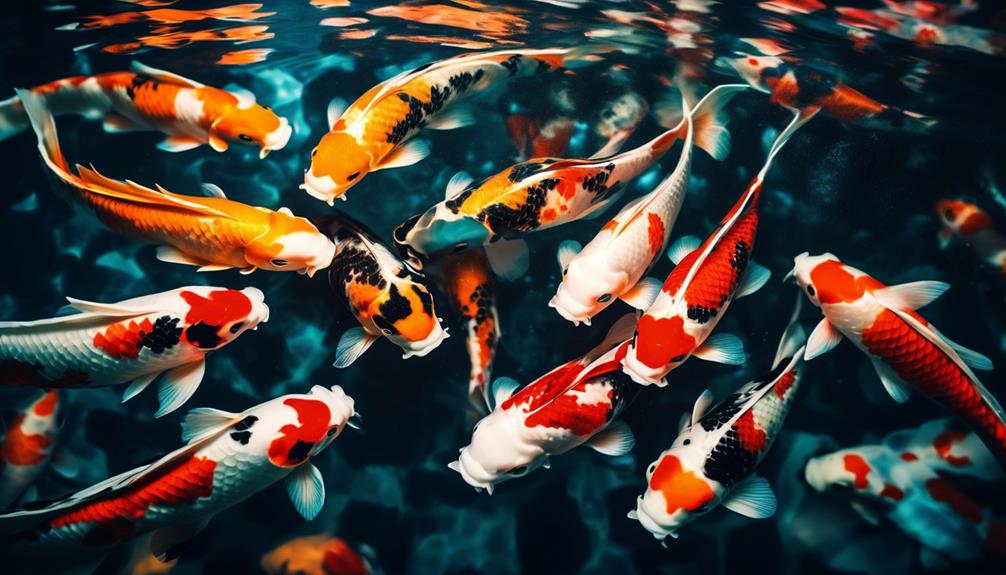
In the world of aquatic wonders, there exists a creature that boasts a staggering array of colors, captivating the hearts of both seasoned aquarists and curious onlookers alike. With over 20 color patterns and combinations, the Koi fish brings a vibrant and enchanting presence to any aquatic setting.
But there's more to these mesmerizing creatures than meets the eye. As we delve into the colorful world of Koi fish, prepare to uncover the secrets behind their captivating hues and discover the fascinating journey that awaits.
Key Takeaways
- Koi fish are large, freshwater fish that can grow to lengths of over 24 inches.
- They have a non-aggressive temperament and can be kept in large aquariums or ponds of 1000 gallons or more.
- Koi fish come in a wide variety of colors, with thousands of color combinations.
- When breeding koi fish, it is important to provide a high protein diet and look for heavily planted areas for egg laying.
Koi Fish Information
Koi fish, known for their vibrant colors and graceful swimming, are a popular choice among freshwater aquarium enthusiasts. These large fish can grow to lengths of over 24 inches and have a non-aggressive temperament. They thrive in large ponds of 1000 gallons or more, with medium hard, pH neutral water that's moderately cold.
Koi fish should be kept in large shoals and shouldn't be housed with slower or smaller species of fish. Their diet consists of specialized pellets and sticks, with occasional treats. Breeding occurs during late spring/early summer months, and spawning mats are used to prevent destruction of plant growth.
Koi fish originated from the common Asian carp and were selectively bred in China and Japan to create different color variations.
Suitable Tank Mates
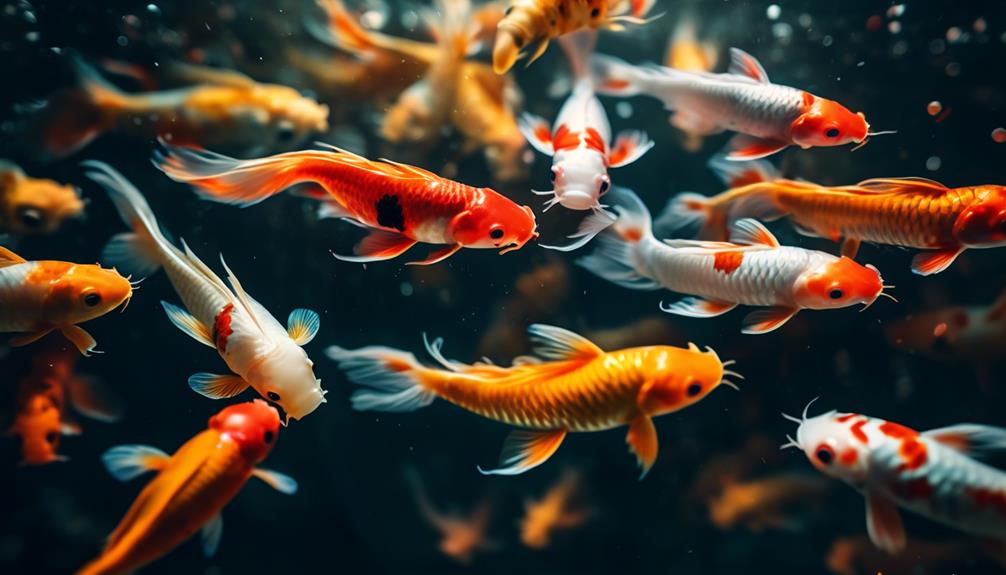
When considering tank mates for your Koi fish, it's important to choose compatible species that can coexist peacefully in the aquarium environment. Other Koi fish are a suitable option, as they share similar temperaments and requirements.
Common goldfish and comet goldfish can also be good companions for Koi, as they're non-aggressive and can tolerate similar water conditions.
Various species of catfish, such as Plecos or Corydoras, can also make suitable tank mates, as they're bottom dwellers and generally peaceful.
It's important to avoid keeping Koi with slower or smaller species of fish, as they may be outcompeted for food or become targets for aggression.
Breeding
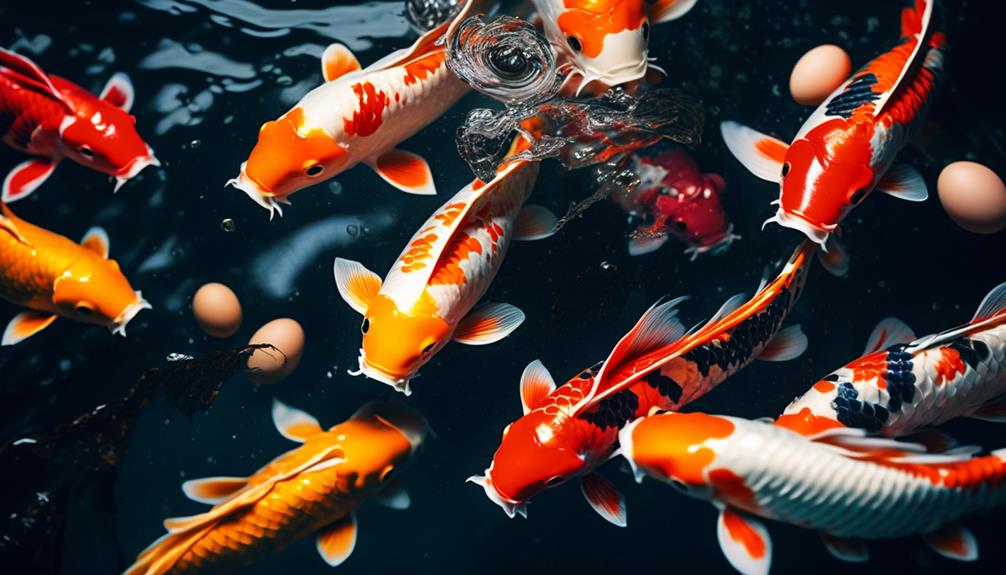
The process of breeding Koi fish involves encouraging spawning through a high protein diet and increased feeding during the late spring and early summer months. This stimulates the fish's reproductive system and triggers the release of eggs and sperm.
To further facilitate breeding, it's important to provide heavily planted areas where the fish can lay their eggs. Using a spawning mat can help protect the eggs and prevent destruction of plant growth.
Once the eggs are laid, the spawning mat should be removed and the fry can be fed brine shrimp and crushed flakes.
Breeding Koi fish requires careful attention and dedication, but it can be a rewarding experience for those who wish to expand their Koi population.
Origins
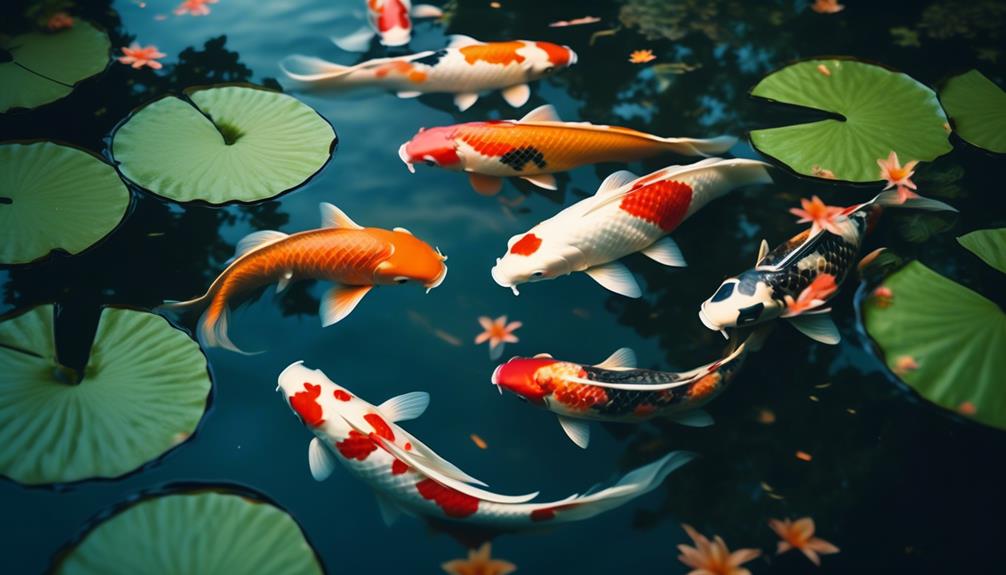
Originating from the common Asian carp, Koi fish were created through natural color mutations that occurred in China and Japan. These mutations caught the attention of the Japanese, who began selectively breeding the fish to enhance their vibrant colors and patterns. Over time, different varieties of Koi were developed, each with its own unique characteristics and beauty.
Today, Koi fish are highly regarded and prized for their stunning appearance. They come in a wide range of colors, including white, black, red, yellow, blue, and cream, with thousands of other color combinations existing. Koi fish are now popular not only in Asia but also in various parts of the world, where they're cherished as ornamental fish in ponds and aquariums.
Aquarium Varieties
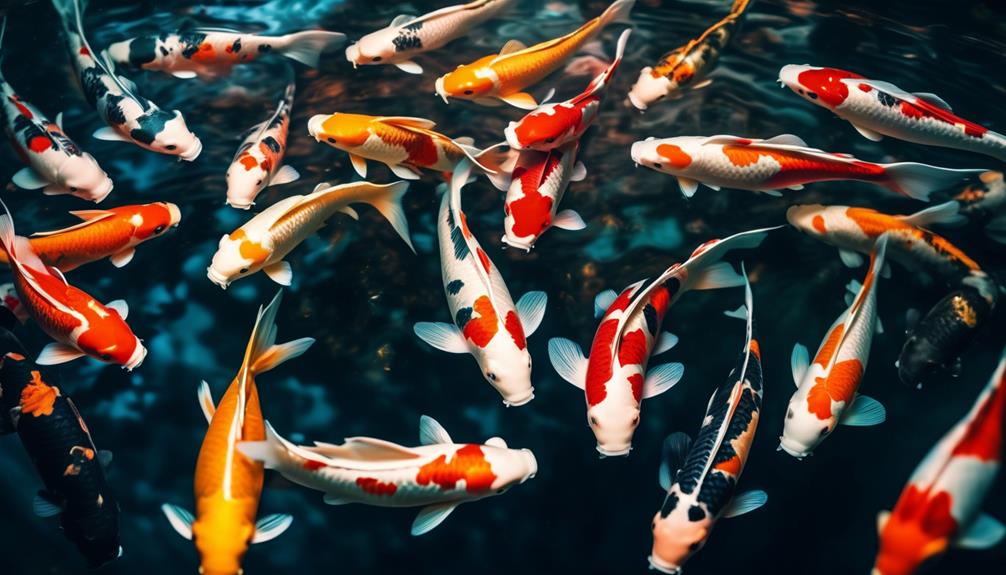
There are several aquarium varieties of Koi fish, each with its own unique characteristics and beauty. These varieties include:
- Kohaku: This variety is characterized by its white body with red markings. It's one of the most popular and widely recognized varieties of Koi.
- Taisho Sanke: Taisho Sanke is known for its white body with red and black markings. It's a vibrant and eye-catching variety.
- Showa Sanke: Showa Sanke showcases a black body with red and white markings. It's a striking variety that adds depth and contrast to any aquarium.
These aquarium varieties of Koi fish offer a wide range of colors and patterns, allowing fish enthusiasts to create visually stunning displays in their aquariums. Whether you prefer the simplicity of a Kohaku or the boldness of a Showa Sanke, there's a Koi variety that will suit your personal taste and style.
Pond Size and Considerations
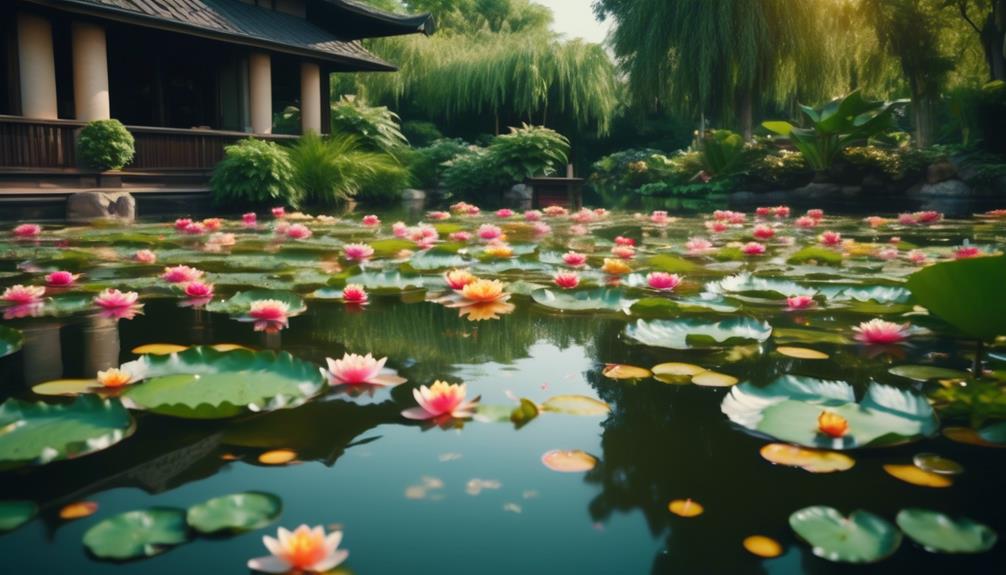
When considering pond size and factors to take into account, it's important to determine the appropriate size based on available resources, such as time, money, and space. Ponds can vary in size, and it's crucial to consider the nitrogen cycle and stocking considerations.
As a general guideline, it's recommended to have at least 10 gallons of water per koi or goldfish in the pond. Additionally, the depth of the pond is important for the winter survival of the fish. In colder climates, a deeper pond provides a more stable environment.
For those with limited space, container ponds can be a compact option. It's essential to filter the water in these ponds to prevent stagnation and maintain the health of the fish.
Colorful Koi Patterns
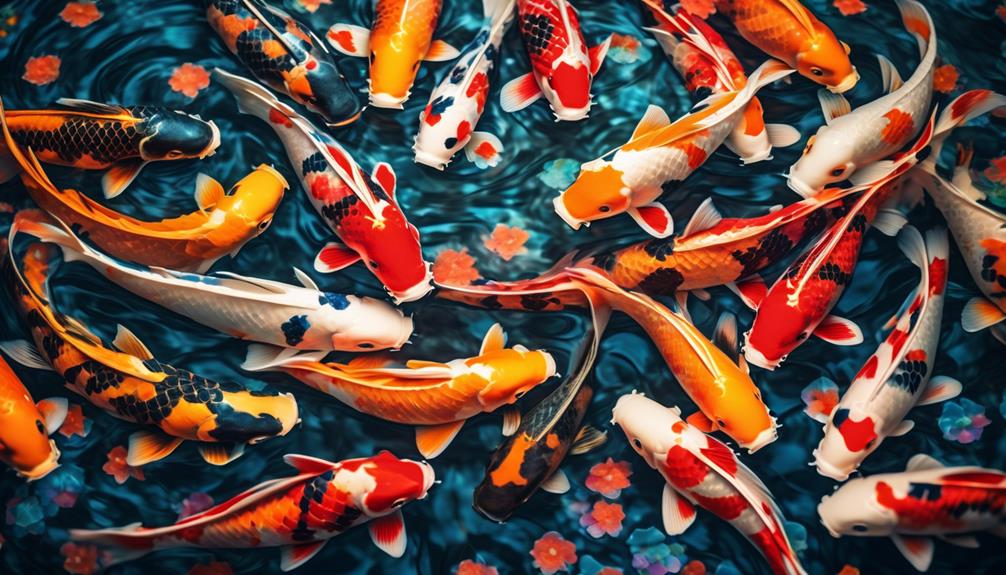
After considering the appropriate pond size and factors to take into account, such as time, money, and space, it's time to explore the vibrant and diverse world of colorful koi patterns. Koi fish come in a wide array of stunning patterns, each with its own unique beauty. Here are three key aspects to know about colorful koi patterns:
- Color Variations: Koi fish display a mesmerizing blend of colors, including shades of white, black, red, yellow, blue, and cream. However, the possibilities are virtually endless, with thousands of other color combinations existing.
- Pattern Types: Koi patterns can vary greatly, with popular varieties including Kohaku, Taisho Sanke, Showa Sanke, and Tanch. Each pattern has its own distinct arrangement of colors and markings, adding to the visual appeal of these magnificent fish.
- Individuality: Just like human fingerprints, each koi fish has its own unique pattern. This individuality makes owning and observing koi fish a truly captivating experience, as you can appreciate the one-of-a-kind beauty of each fish.
With their vibrant colors and intricate patterns, koi fish truly bring a touch of artistry to any pond or aquarium.
Koi Fish Maintenance and Care
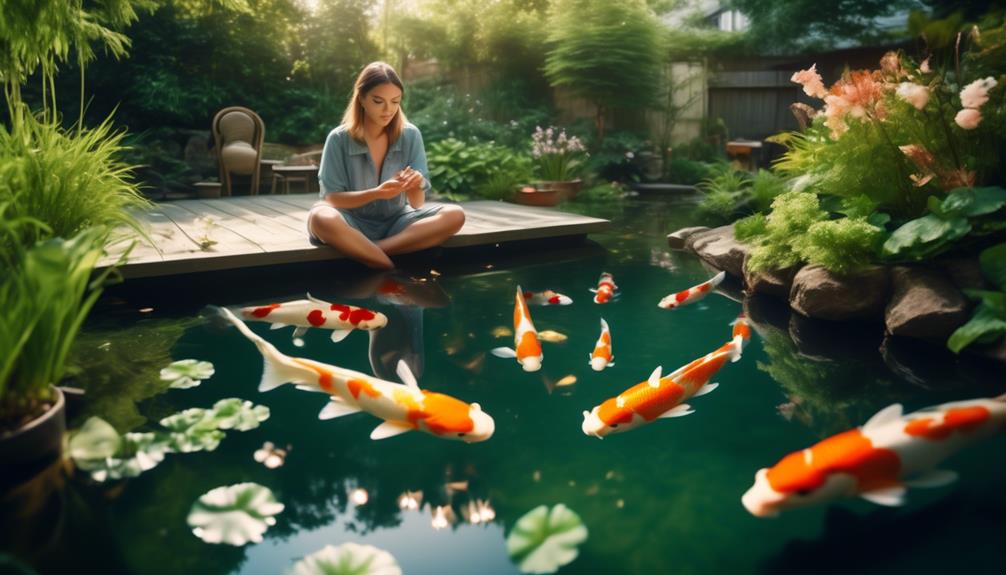
Caring for koi fish requires regular maintenance and attention to ensure their health and well-being. These freshwater creatures thrive in large ponds of 1000 gallons or more, where they can swim freely and socialize with other koi fish.
It's important to maintain a medium hard, pH neutral, and moderately cold water environment for them to thrive. Koi fish are fast swimmers and shouldn't be kept with slower or smaller species of fish.
Their diet consists of specialized pellets and sticks, along with occasional treats. During colder months, their protein content should be lowered.
Frequently Asked Questions
How Long Do Koi Fish Live?
Koi fish can live for a long time. They have an average lifespan of 25-35 years, but some have been known to live for over 50 years. Factors such as water quality and proper care can impact their longevity.
Can Koi Fish Be Kept in a Small Aquarium?
Koi fish cannot be kept in a small aquarium. They require large ponds of 1000 gallons or more to thrive. Koi are fast swimmers and should not be kept with slower or smaller species of fish.
Are Koi Fish Aggressive Towards Other Fish?
Koi fish are non-aggressive towards other fish. They can be kept with other koi, common goldfish, comet goldfish, and various species of catfish. They thrive when kept in large shoals.
Do Koi Fish Require a Specific Type of Water Filtration System?
Koi fish do not require a specific type of water filtration system. However, it is important to have a filtration system that can handle the large size and waste production of koi fish in order to maintain a clean and healthy environment for them.
Can Koi Fish Be Kept in Outdoor Ponds During the Winter?
Koi fish can be kept in outdoor ponds during winter, but the pond must be deep enough for them to survive. The depth of the pond is important for their winter survival.
What are the differences between keeping koi fish and minnows?
Keeping koi fish and minnows are two different experiences. While koi fish are known for their beauty and size, the colorful world of minnows offers a variety of small, active fish suitable for smaller aquariums. Koi need large, deep ponds, while minnows can thrive in smaller environments.
Conclusion
In conclusion, the world of Koi fish is truly a captivating and colorful one. From their mesmerizing colors and graceful presence to their unique patterns and varieties, these majestic creatures bring enchantment to any aquatic setting.
Whether in a freshwater aquarium or a tranquil backyard pond, Koi fish are sure to captivate the attention of aquarists and nature enthusiasts alike. With the right care and maintenance, these beautiful creatures can thrive and bring joy for years to come.

